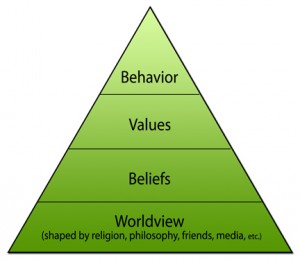Besides being a beautiful addition to the classroom, the biblical integration posters are an excellent resource for planning as well as instruction. The major principles on the posters identify many of the major tenets of the Christian faith. To use the posters most effectively, both the teacher and the students should be familiar with the information on them.
In addition to the text below, the video below highlights how to use the posters in the classroom.
The following are just a few suggestions of ways the posters have been used all around the world.
Planning
What are the major biblical principles?
Which biblical principles apply to the lesson?
Many teachers are not quite sure which biblical concept to focus on when teaching. The posters include over 30 of the most common principles used in the classroom. Naturally these are not the only principles that apply but the posters do provide a convenient list for planning units and individual lessons. See the brainstorming page for ideas on how to biblically integrate a unit and the lesson plan page for how to create an individual biblically integrated lesson.
Reference Material
Many students do not naturally think biblically about many school subjects. More often than not, that is a reflection of upbringing in and out of school. The goal of Christian education is to help students to think biblically and critically. The posters provide a mechanism for that. On a simple and direct level, a teacher can use the posters as a point of reference when discussing the biblical principle that applies to the lesson.
Once the teacher feels that the students are fairly familiar with the information on the posters, he can then ask the students to identify which biblical principle applies to the lesson, and how. This can be done openly to the class by asking the students to identify a biblical principle from any poster, or it can be done more directly by asking students to identify a principle from a specific poster.
Initially, students may feel more comfortable being asked which principles apply in an open forum, meaning where any student can respond. Some students may need a little longer to make the connections between the topics and the biblical principles, and they will benefit from hearing other students make the connections. Ultimately, the goal is for each student to be able to identify biblical principles that apply to the various lessons.
Assessment
Should the students’ abilities to identify the major biblical principle that applies to instruction be assessed?
Schools may have different positions on this issue, but one should keep in mind that assessment is a way of checking to see if students have learned what was instructed. Certainly if the class has never covered an issue, then to assess it would be inappropriate. The same goes for biblical integration. Students should not be expected to identify biblical principles on exams if they have not been exposed to that during instruction.
What about non-Christian students? Is it fair to ask them to identify biblical principles? If the assessment is clear, students will be asked to identify what has already been covered during instruction, what Christians believe. Being asked to identify what Christians believe is not the same as grading them on what they personally believe. In learning about different world religions, it would be appropriate to have students identify the major tenets of other religions on an exam. Likewise, it is appropriate to ask students to identify the basic tenets of Christianity and how they relate to the lesson.
This can be a sensitive issue and teachers may want to discuss this further with their principal or administrator.
Worldview Study Format
As an upper elementary teacher and middle school teacher, I noticed that my students were able to grasp the idea that not everyone believes the same things; everyone has their own worldview. Further, they could also understand how those beliefs translated into values and behaviors that not only influenced individuals, but society at large as well.
- The eugenics movement in the early 20th century in the United States led to the sterilization of thousands of people, which sprang from the philosophy of Social Darwinism.
The exciting thing about studying worldviews with students is helping them understand how one develops a worldview, how it shapes people’s lives, how behavior reflect one’s worldview, and how the students can be more effective agents of change.
- Communism springs from the premise that social problems are a result of economic issues, whereas Christianity finds that social problems are a result of the state of man, that he is made in the image of God but has a sin nature.
The posters list many of the main tenets of the Christian faith in five major categories: God, creation, mankind, moral order, and purpose. The five categories not only help students think about the different academic subjects from a biblical perspective, they also provide a template for studying other worldviews. What do other religions or philosophies say about the character or nature of God, creation, mankind, moral order, or purpose?
One of the best ways to compare and contrast worldviews is by establishing a base knowledge. Before delving into other worldviews, it is best to make sure the students have a strong grasp of the Christian worldview. Through a deliberate and careful study of the ramifications of various religions and philosophies, students can come to see how truly beautiful and powerful God is, and how transforming the Christian faith can be (Romans 12:1-2).



